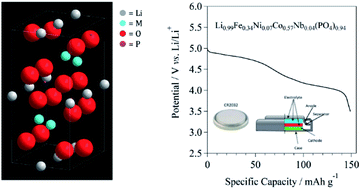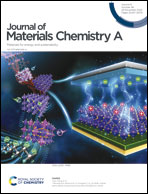High valence transition metal-doped olivine cathodes for superior energy and fast cycling lithium batteries†
Abstract
Mixed-metal olivine cathode materials are one of the most promising systems in the field of lithium batteries. Their main drawback is their low electronic conductivity, which limits the current rate at which they can be cycled. Herein, the effect on electrochemical properties of vicariant high-valence transition metals (HVTMs) inserted in the olivine crystal structure has been studied. The strategy adopted herein consists of doping a LiFe1/3Ni1/15Co3/5PO4 cathode by substituting part of the cobalt(II) ions with vanadium(IV), niobium(V), or tantalum(V) HVTMs. The WAXD studies reveal that small HVTMs in molar quantities (HVTM/P = 0.04) are vicariant into the olivine crystal lattice. Single-cell tests show that the Nb-doped cathode has a high-voltage (ca. 4.5 V) and a specific capacity of 149 mA h g−1 (656 mW h g−1). Thus, the insertion of HVTMs in the cathode structure exceptionally improved the electric conductivity of the material and yielded an improved cyclability and rate capability owing to its electro-compensation effect.



 Please wait while we load your content...
Please wait while we load your content...